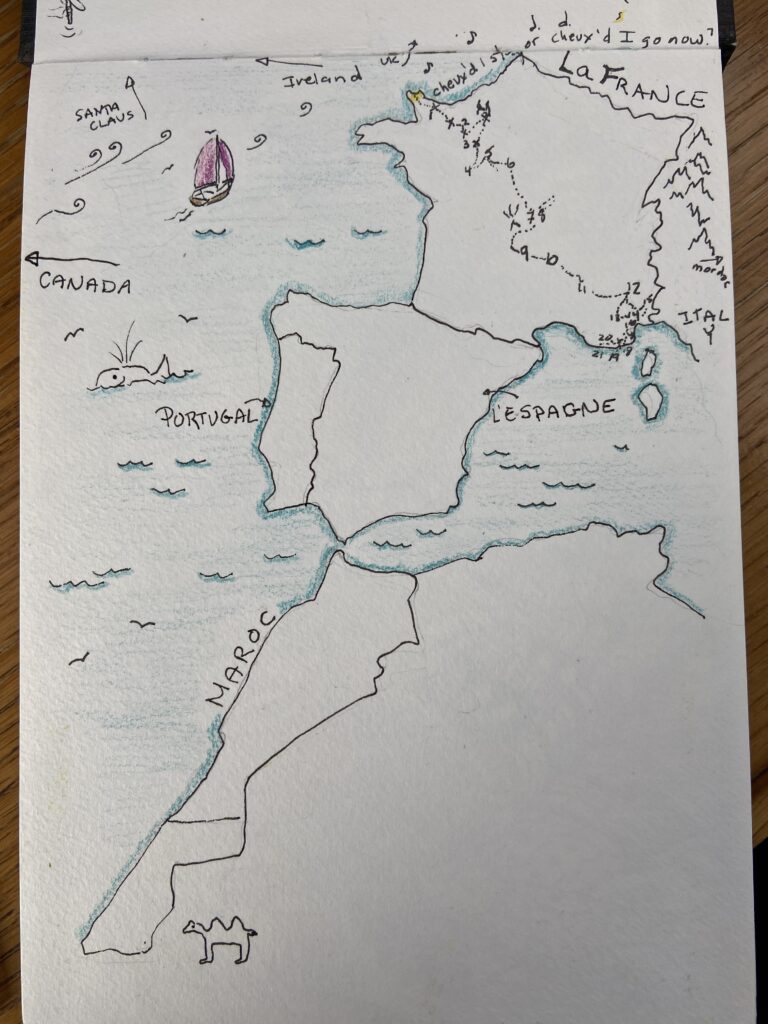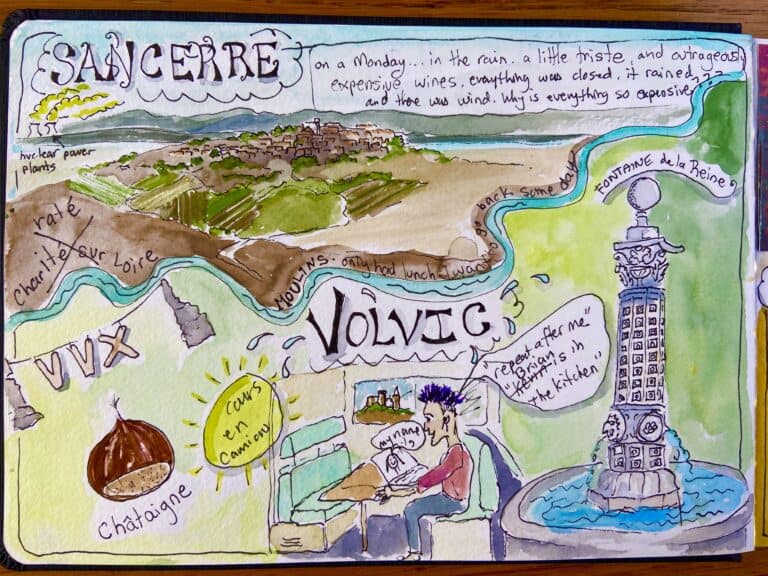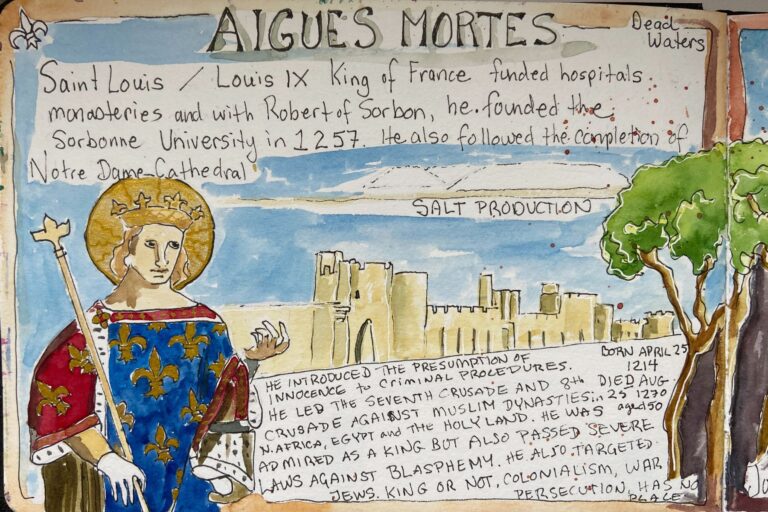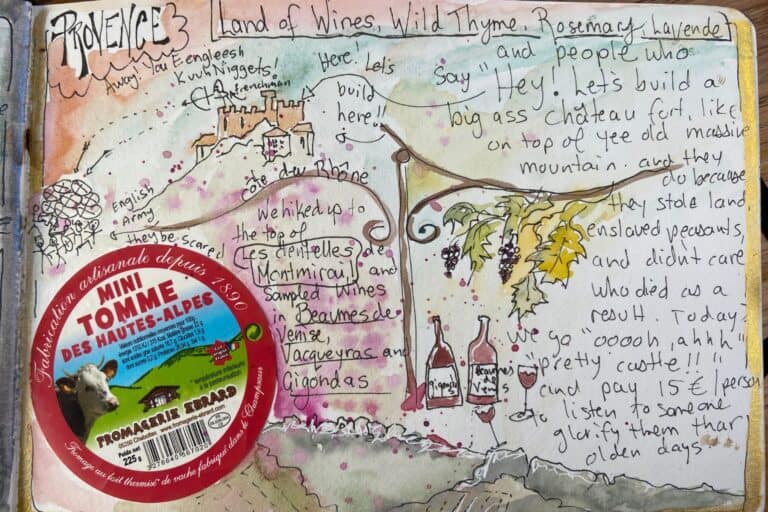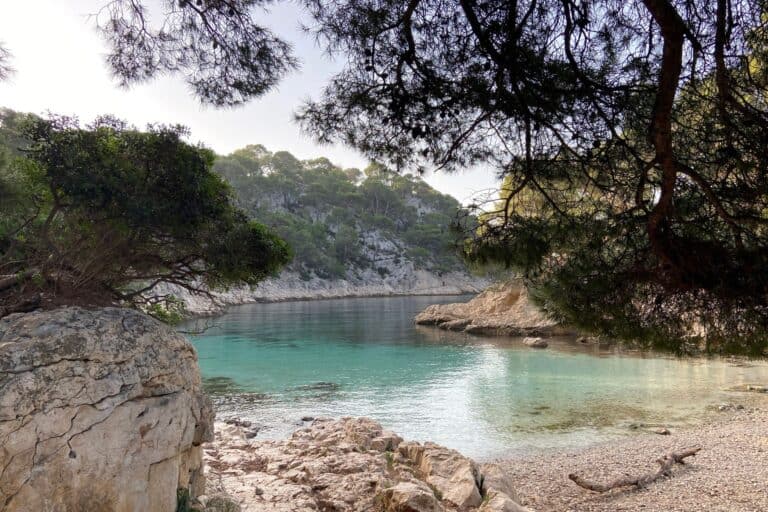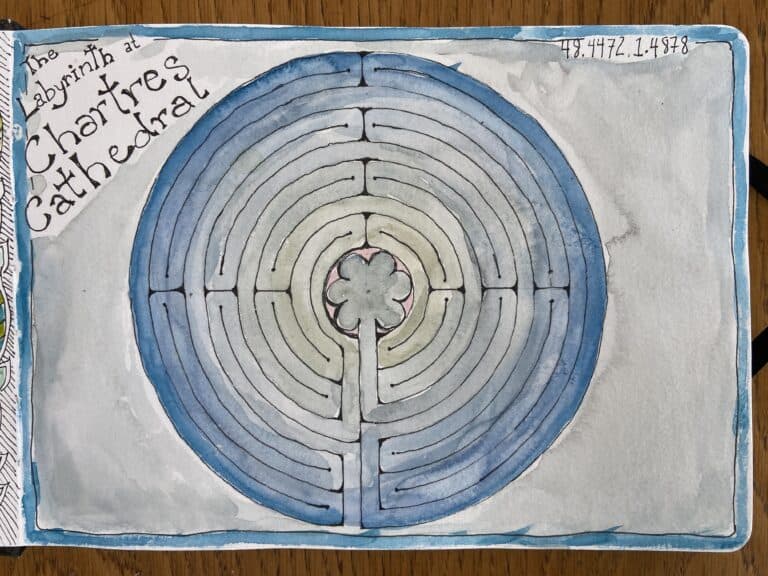Leg 7: Provence, Roussillon and le Côte d’Azur
Just a note that if you missed my last post on January 17th, it’s cuz it somehow didn’t get sent out. Click here to read it. Sorry.
We were tired of the cold nights and it was time again to see the ocean. It was October and after we drank some yummy wines in Côte du Rhône, we decided to spend one long day of travel to reach the south coast of France.
Oh wait. But we decided to stop along the way to visit Roussillon.

I’d been wanting to see this town ever since I started using watercolour paints. Why? Because Roussillon is the home of French Ochre, an amazing, earthy, yellowish brown adored the world over by painters. And I am a self declared pigment nerd.
What is a pigment?
A pigment is basically a fancy name for a colour. It can be made of animal, vegetable and mineral. It can also be natural, manipulated by heating and other means and it can also be made in a lab. One of my favourite colours is called dioxizine purple. It’s yummy. Apparently there are even pigment snobs out there who refuse to use manmade pigments, only opting for natural pigments and so on. Kind of like people who refuse to wear polyester. I am an equal opportunity pigmenter. I will use any colour if it’s pretty but apparently sometimes natural and manmade pigments don’t blend well. Whatever.
How can you tell one pigment from another?
If you’re not colourblind, then you likely can see different colours. I’m not talking about that. What I mean is, there are different kinds of blues, for example because they are made up of different types of pigments. Premade paints, be they acrylics, gouache, oil or watercolours, can be made up on a single pigment or a blend of pigments that are called convenience colours.
I collect single pigment watercolour paints, and in order to identify them, they are given special codes.
What are pigment codes?
There are two parts. The lettering goes generally like this. P = pigment Y=yellow / R= red / B= blue / G= green and so on. The second part is usually a number, that identifies the specific pigment. Like PB50, PR122 and so on.
One of my favourite colours is ultramarine blue. Originally, this colour was made with the precious lapis lazuli stone but today most ultramarine blue is synthetic. I don’t care. It’s still gorgeous. The code is PB 29, which should be listed on the label, of any reputable paint company, in teeny tiny letters. Ta da. That’s pigment coding 101.
What is Lightfastness?
There is also one other persnickity thing I pay attention to and that’s never to use what are called “fugitive” paints. I love that word. I can imagine a tube of paint sneaking around with a mask on. Fugitive means a paint that fades fast in natural daylight, like alizarin crimson.
Companies provide lightfast ratings but most of them are created using oil based paints or acrylics that don’t behave in the same way as watercolours do. I did lots of research on lightfastness and it’s irritating. If you want to learn more about pigments then I suggest going to a wonderful artist’s site. Her name is Kim Crick and she’s got a super database with explanations on pigments, blends and so on. Visit her here.
Sometimes companies come up with super cool blends of paints and include a fugitive pigment in the blend so that after a few months the painting changes colour or fades terribly. If I spent several thousand dollars on a painting only to have it fade out on me, I’d be kind of mad. So, if you’re ever buying original art from someone and ask them whether they use fugitive pigments and they stare at you blankly, you might want to reconsider the purchase.
So, what is ochre?
It’s a natural earth clay pigment with other stuff in it and in Roussillon, in 1780, this dude named Jean Etienne Astier figured out how to process natural ochre into a non toxic, stable dye. It was a big hit and those amazing colours you fantasize about when you think of houses in Provence were all originally painted with ochre paints.

So, me all happy to come to pigment mecca, we toodled into town and parked right up top in the parking lot. Don’t do that if you have a big rig. Park way down below in the special campervan parking lot or you’ll be in big big trouble. We wanted to go on the special walk through the mine, which is no longer in activity.
We walked up to the ticket office, my husband shaking his head because you used to be able to just go for a wander around the mine by yourself, but some clever person thought it was a good idea to put up a gate and charge people. Alas, we arrive to see a sign saying, “Fermature exceptionelle, aujourd’hui.” (Exceptional closure today.)
Huh. It’s France. We popped into a store next to the entrance and the nice lady told us that yes, it was closed due to hangover. Apparently the young bucks running the place partied too hard the night before so they didn’t open.

We wandered up and through the town, where I ended up buying three pigments from a guy who had no idea that pigments even had codes. He told me they came from a place ten kilometres away, but who knows if they’re even really from France. Once I get home, I will make up my own watercolour paints and see what they’re like. Stay tuned. Oh and if this topic is of interest and you want to know more about what paints and supplies I use, let me know. I’d love to do a non-travel related post or two.
The French Riviera
The next day we drove all the way south to le Lavendou and ended up parking a little farther down the road at La Croix-Valmer. We stopped for a short while on a side road leading down to the ocean and actually went swimming. It was October 22nd, 2022 and it was amazing. We then popped back into the van drove a little further along and parked on a stretch of road overlooking the ocean. While there were no camping car signs along the road, the meters were also all wrapped up in plastic bags so we decided to tempt fate and park there anyway.
I made pasta and we were sitting drinking wine with the door open digesting dinner when a couple strolled by. I called out to them, “it’s time for dessert!” in English and they did an about face and came to see us. We ended up talking for half an hour and it turns out the man is a well known author of political thrillers. I won’t tell you his name but he’s famous and they have a house in the area.

The next thing we knew, my husband boldly invited us over to their house for breakfast the next day to continue the conversation, saying we’d bring croissants. Alas, they insisted that they would get them, so the next morning we headed over to our new friends’ home and were treated to great coffee, croissants and the most lovely, generous, unpretentious and intelligent people I’ve met in a very long time. I love moments like this. Such generous, trusting and warm people and we left feeling like we’d made new friends.
After that we headed back to Plage St. Claire where we camped right in the parking lot on the ocean. All of the parking meters are covered up in plastic in the winter and no one bothered us. We met a lovely German gal on a year long work sabbatical and we also visited with our English friend who spends winters in the south.
It was a lovely time and I even saw a little octopus while I was swimming.
What the Côte d’Azur really like?
It’s really nice when there are no tourists there. Most of the restaurants are closed up by the end of September and the food shops are stupidly overpriced. So stock up on good food and wine before you come or you’ll pay through the nose. Most of the tourist places we visit off season can be kind of ghost town-like. You wander around town, spying German and Dutch tourists looking a bit forelorn,(aka, hungry), as they peer through closed restaurant windows, sighing. Oh, wait, no, that was me.
Alas, I will never go to any popular tourist spot in high season. It’s packed, you’re forever in traffic jams, it’s hot and there’s nowhere to park, stay or wild camp. That’s not my idea of a holiday. Next time, we keep making our way down through Toulon, Cassis and then towards the Camargue.

